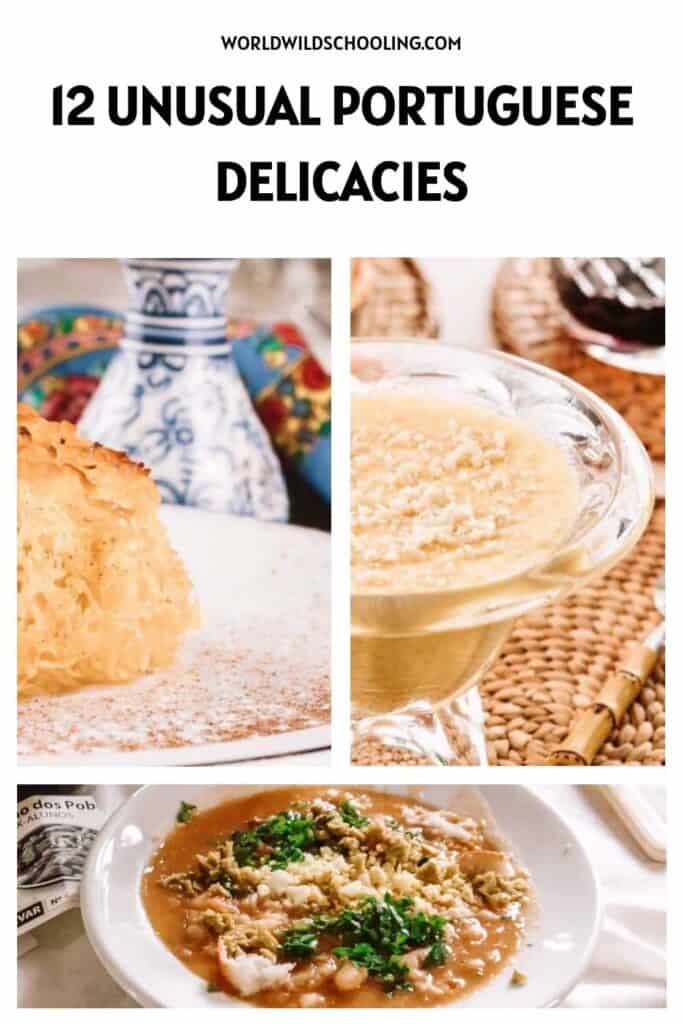These Weird Portuguese Dishes Are Not for the Faint of Heart, From Fermented Treats to Unexpected Seafood Pairings
All recommendations on World Wild Schooling are independently selected by our editors. We may earn an affiliate commission from purchases made through our links.
If you love your foods, which, let’s face it, who doesn’t, and you’re planning a vacation to Portugal, you’re in luck because Portuguese cuisine has much to offer. Portugal has everything from fresh seafood and delicious local produce to beautiful wines and tasty sweet treats. However, Portugal hides a world of strange and obscure foods beyond its famous cuisine.
For example, did you know cows’ hooves and eel eyes are popular in Portugal? If not, you’ve come to the right place. In this list, you’ll find 12 weird foods in Portugal. If you want to try something completely different and test your tastebuds, try one of the foods from this list.
Swipe and Vote: See What Travelers Recommend
Feeling adventurous? Which of these delicacies would you actually try in Portugal?
This is a swiper quiz, swipe right for yes, swipe left for no.
 © Julimatic / Shutterstock
© Julimatic / Shutterstock
 © Szakaly / Adobe Stock
© Szakaly / Adobe Stock
 © Joao Manita / Shutterstock
© Joao Manita / Shutterstock
 © Marcelo Trad / Shutterstock
© Marcelo Trad / Shutterstock
 © Eugenio Hansen / Wikimedia Commons CC BY-SA 3.0
© Eugenio Hansen / Wikimedia Commons CC BY-SA 3.0
Results
 1
1
 2
2
 3
3
 4
4
 5
5
Mão de Vaca Com Grão

At first glance, mão de vaca com grão looks incredibly delicious. However, you might find it hard to stomach when you hear what goes into making it. For the most part, this traditional Portuguese dish consists of pleasant ingredients, including sausage and chickpeas, but things quickly take a turn for the worse.
A seemingly unnecessary and weird inclusion in mão de vaca com grão is cows’ legs, specifically cows’ hooves. This dish originated in Angola, Central Africa, where Portuguese explorers adopted it and brought it home. As a main dish, mão de vaca com grão has a rich, salty, earthy, savory flavor and a smooth, gamey texture.
Read also: Excellent Dishes To Try in Portugal
Omelete de Mioleira

Generally speaking, the humble omelet is a safe option for fussy eaters to order when traveling. After all, it typically only contains eggs, cheese, and vegetables. However, in Portugal, fussy eaters should order omelets with caution because omelete de mioleira is one of the world’s weirdest types of omelet.
So, what makes this omelet dish so strange? Well, the simple answer to that question is brains. Yes, you read that right; omelete de mioleira contains brains. This medieval-style dish is usually made of calves’ brains or pigs’ brains, raw eggs, salt, and pepper. Some versions of the dish also contain greens like spinach or kale. Luckily, the brains’ odd taste and creamy texture are less pronounced in an omelet.
Read also: Things To Avoid When Visiting Portugal
Baba de Camelo

Baba de camelo makes our list not because of how it tastes or what it consists of but because of its weird name instead. Translated to English, baba de camelo means “camel drool,” which, for obvious reasons, doesn’t sound like the most delicious of dishes. However, beyond the strange name, this dish is super tasty.
Baba de Camelo is a traditional caramel dessert with a mousse-like texture. It’s usually made using condensed milk and eggs and topped with crushed almonds, ice cream, or chocolate. This vibrant dessert is likely called baba de camelo because of its camel color and slightly runny texture, which falls off your spoon like drool.
Read also: Affordable Beach Towns in Portugal
Caracóis

If you’ve been to France before, you might have tried something similar to this Portuguese delicacy, as they have a slightly different variety called escargot, which is French for snails. In Portugal, the type of snails people eat are called caracóis, and they supposedly go very well with a chilled beer.
So, maybe the next time you go to a bar in Portugal, don’t buy a bag of peanuts; treat yourself to a plate of snails instead. Most chefs in Portugal cook this unusual snack in garlic and oregano to enhance its flavor. They are then served on their own or in a broth. Compared to French snails, caracóis are much smaller. Their taste and texture are like sauteed mushrooms.
Read also: Famous Landmarks in Portugal
Courato

Courato is a popular street food dish in Portugal, primarily served outside sports stadiums and at festivals and fairs. So, what is it? Simply put, courato are pieces of pork skin. They are usually eaten as a snack after being seasoned and deep-fried until crispy and golden. They aren’t too dissimilar to pork scratchings and pork crackling.
Often, the courato is marinated in white wine, black pepper, garlic, bay leaves, and red bell pepper before it hits the fryer. When it’s ready, you can eat the courato on its own or shove it in a Portuguese roll. Rumor has it that courato washes down nicely with an ice-cold Portuguese beer.
Read also: Serene Retirement Spots in Portugal
Fios de Ovos

The next weird Portuguese food on our list is fios de ovos, an utterly bizarre sweet treat that we can’t quite get our heads around. Fios de ovos, or egg threads, is a traditional Portuguese sweet made of egg yolks. We’re not sure if it’s a genius idea or a crazy one, but the egg yolks taste surprisingly delicious when ready.
To make fios de ovos, egg yolks are turned into thin strands before being boiled in sugar syrup. After being boiled, they look like silly string or angel hair. They have a delicate texture and a lovely flavor. Most people in Portugal stuff their egg threads into cakes and puff pastry.
Read also: Portugal’s Stunning Beach Getaways
Save this
Iscas com Elas

If you’re a carnivore who thrives on dishes brimming with meaty goodness and unique animal cuts, iscas com elas is perfect. If you’re not a big meat eater, the thought of eating marinated liver and onions isn’t appealing. However, we still recommend trying this hearty marinated liver dish.
To make iscas com elas, the calf’s liver is cut into thin slices and marinated overnight in beer or wine, garlic, bay leaves, pepper, and citrus. The following day, the liver is fried in a pan with onions before being served on a bed of French fries. Admittedly, the liver doesn’t look tasty but has a slightly sweet and rich earthy flavor. This dish is prevalent in Lisbon.
Read also: Must-See Castles in Portugal
Enguias

Residents of London, the capital of England, might be used to eating eels in the form of jellied eels, but most people worldwide haven’t had the pleasure, or should we say displeasure. If, for whatever reason, you feel compelled to try eel, make sure you order enguias during your Portugal vacation.
In Portugal, eels are often served with their head and eyes intact. Sounds pretty awful, right? However, this is a local delicacy that many locals across the country enjoy. The fish is usually fried and eaten with a pickled onion sauce, although many people also like to stew it. Regarding taste, enguias is compared to fatty fish like salmon and trout, but with a more robust flavor.
Read also: Portugal’s Hidden Gems
Burras Assadas

When we used Google Translate to look at the meaning of burras assadas, we were shocked to discover it means roasted donkey in English. Luckily, our horror was short-lived when we learned the dish wasn’t donkey. Instead, burras assadas are roasted pork. However, we were shocked again when we saw burras assadas.
While roast pork is perfectly acceptable in most cases, what seems strange to us is eating a pig’s jawbone, which is usually used to make this dish. As such, if you order burras assadas in a Portuguese restaurant, don’t be surprised to receive a plate of French fries with a jaw and teeth on top. Unless you’re a dentist, it’s best to order something else.
Read also: Portugal’s Hidden Gems
Dobrada

The penultimate weird food on our list is dobrada, a traditional Northern Portuguese dish that features tripe. For those who don’t know, tripe is the stomach lining of various farm animals, including cows, sheep, and pigs. Despite tripe being an acquired taste, dobrada is also a big hit in Brazil.
A type of stew, this dish is jam-packed with flavorful ingredients and spices. The tripe is flavored with tomato paste, paprika, garlic, clove, and red pepper paste. Carrots, butter beans, and onions are also included in the recipe. Once ready, the stew is most commonly served with rice. In Porto, you’ll see dobrada called tripas à moda do Porto.
Read also: Budget-Friendly Small Towns in Portugal
Choco com Tinta

Despite being surprisingly tasty, choco com tinta is arguably the most unappealing and unappetizing Portuguese food on this list. Translated to English, choco com tinta means “cuttlefish with ink,” which is exactly what this dish is. Across Portugal, cuttlefish can be ordered without ink, but most people order it with it.
After a few bites of this bizarre food, your tongue and teeth will be smothered in dark black ink. Regarding flavor, cuttlefish is a genuinely tasty fish known for its fresh, rich flavors and aromatic flavors of the ocean. Meanwhile, the ink has a neutral taste that doesn’t enhance or detract from the fish’s flavors. Therefore, the ink is more of a gimmick than a flavorful ingredient.
Read also: Portugal’s Tourist Traps To Avoid
Maranho

Last but certainly not least is maranho, a traditional Portuguese dish gifted to us by Sertã in the Beira Baixa region of Central Portugal. It’s a goat-based dish with a combination of goat meat, ham, mint, rice, and chouriço stuffed and sewn into a goat stomach. It might sound unappetizing, but it’s surprisingly tasty.
The fusion of aromatic flavors and gamey texture is unique but delicious. However, we can see the rubbery and bumpy texture of the stomach, understandably putting people off. Most people in Portugal serve maranho with potatoes and homemade bread during the festive Christmas period. So, what do you think? Are you willing to give it a try?
Read also: Fairy Tale Villages in Portugal
Pin It Now, Read It Later











